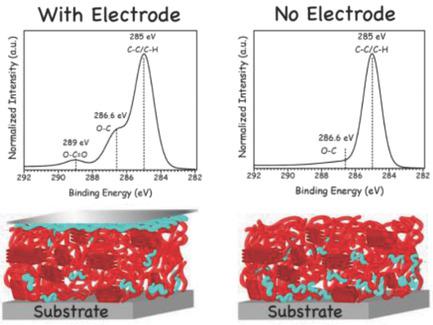当前位置:
X-MOL 学术
›
Adv. Mater.
›
论文详情
Our official English website, www.x-mol.net, welcomes your
feedback! (Note: you will need to create a separate account there.)
Interlayers Self‐Generated by Additive–Metal Interactions in Organic Electronic Devices
Advanced Materials ( IF 27.4 ) Pub Date : 2018-07-10 , DOI: 10.1002/adma.201706803 Jane Vinokur 1 , Igal Deckman 2 , Tanmoy Sarkar 1 , Liza Nouzman 1 , Basel Shamieh 1 , Gitti L. Frey 1
Advanced Materials ( IF 27.4 ) Pub Date : 2018-07-10 , DOI: 10.1002/adma.201706803 Jane Vinokur 1 , Igal Deckman 2 , Tanmoy Sarkar 1 , Liza Nouzman 1 , Basel Shamieh 1 , Gitti L. Frey 1
Affiliation

|
The fundamental structure of all organic electronic devices is a stack of thin layers sandwiched between electrodes, with precise intralayer morphology and interlayer interactions. Solution processing multilayers with little to no intermixing is, however, technically challenging and often incompatible with continuous roll‐to‐roll, high‐speed manufacturing. Here, an overview of a recently developed methodology for self‐generation of interlayers positioned between the active layer and metal contact is presented. The interlayer material is blended as an additive in the active layer and migrates to the organic/metal interface during metal deposition. The driving force for this migration is additive–metal interactions. The generated interlayer positions an interfacial dipole that reduces barriers for charge transfer across the organic/metal interface. This methodology is generic and, as reported here, the self‐generated interlayers significantly improve the performance of many devices. Importantly, this approach is compatible with printing and reel‐to‐reel processing. Directives toward additive selection, processing conditions and integration in future applications are also discussed.
中文翻译:

由有机电子设备中的加金属相互作用自行生成的中间层
所有有机电子设备的基本结构是夹在电极之间的一叠薄层,具有精确的层内形态和层间相互作用。然而,几乎没有或根本没有混合的溶液加工多层技术具有挑战性,并且通常与连续的卷对卷,高速制造不兼容。在此,概述了最近开发的一种用于自生成位于有源层和金属触点之间的中间层的方法的概述。中间层材料作为添加剂混入活性层中,并在金属沉积过程中迁移到有机/金属界面。这种迁移的驱动力是添加剂与金属的相互作用。生成的中间层放置了一个界面偶极子,该偶极子减少了跨有机/金属界面进行电荷转移的势垒。这种方法是通用的,如此处所述,自生成的中间层可显着提高许多设备的性能。重要的是,这种方法与印刷和卷到卷处理兼容。还讨论了有关添加剂选择,加工条件和将来应用中的集成的指令。
更新日期:2018-07-10
中文翻译:

由有机电子设备中的加金属相互作用自行生成的中间层
所有有机电子设备的基本结构是夹在电极之间的一叠薄层,具有精确的层内形态和层间相互作用。然而,几乎没有或根本没有混合的溶液加工多层技术具有挑战性,并且通常与连续的卷对卷,高速制造不兼容。在此,概述了最近开发的一种用于自生成位于有源层和金属触点之间的中间层的方法的概述。中间层材料作为添加剂混入活性层中,并在金属沉积过程中迁移到有机/金属界面。这种迁移的驱动力是添加剂与金属的相互作用。生成的中间层放置了一个界面偶极子,该偶极子减少了跨有机/金属界面进行电荷转移的势垒。这种方法是通用的,如此处所述,自生成的中间层可显着提高许多设备的性能。重要的是,这种方法与印刷和卷到卷处理兼容。还讨论了有关添加剂选择,加工条件和将来应用中的集成的指令。











































 京公网安备 11010802027423号
京公网安备 11010802027423号